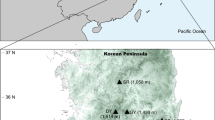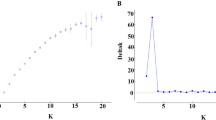Abstract
Silver fir presently occurs in many mountainous regions of eastern, western, southern and Central Europe. In order to elucidate the biogeographic history of fir populations in different European areas, the distribution of area-specific alleles at eight enzyme loci and the allele frequency distributions at seven polymorphic enzyme loci were investigated in seed or bud samples from 48 provenances comprising 98 single stands. Due to great genetic divergence among different populations located near the ancient glacial retreats, it was concluded that silver fir survived in five refugia during the last glaciation but migrated from only three refugia to its present natural range. The occurrence of unique alleles in particular fir areas indicated its migratory routes to the north and the existence of a few introgression zones where silver fir from different refugia has met during its expansion.
Similar content being viewed by others
References
Bergmann, F., 1991: Causes and consequences of species-specific genetic variation patterns in European forest tree species. Examples with Norway spruce and silver fir. — InMüller-Starck, G., Ziehe, M., (Eds): Genetic variation in European populations of forest trees, pp. 192–205. — Frankfurt a. M.: Sauerländers.
, 1988: The genetic variation pattern of silver fir (Abies alba) in Europe monitored from enzyme gene loci. — InPaule, L., Korpel, S., (Eds): Proceedings 5. IUFRO Tannensymposium Zvolen, pp. 21–26. — Zvolen (Slowakei): VSLD.
, 1990: Levels of genetic variation in European silver fir (Abies alba). Are they related to the species' decline? — Genetica82: 1–10.
Bertsch, K., 1935: Der deutsche Wald im Wandel der Zeiten. — Tübingen.
Breitenbach-Dorfer, M., Pinsker, W., Hacker, R., Müller, F., 1992: Clone identification and clinal allozyme variation in populations ofAbies alba (Mill.) from the Eastern Alps (Austria). — Pl. Syst. Evol.181: 109–120.
Damian, M., 1978: Cercetari privind variabilitatea bradului (Abies alba Mill.) din R.S. Romania in vederea extinderii in cultura a provenientelor valoroase [Untersuchungen zur Variabilität der Weißtanne in Rumänien]. — Dissertation, University of Brasov, Romania.
Deichsel, G., Trampisch, H. J., 1985: Clusteranalyse und Diskriminanzanalyse, pp. 12–26. — Stuttgart: Gustav Fischer.
Fady, B., Conkle, M. T., 1992: Segregation and linkage of allozymes in seed tissues of the hybrid greek firAbies borisii-regis Mattfeld. — Silvae Genetica41: 273–278.
, 1993: Allozyme variation and possible phylogenetic implications inAbies cephalonica Loudon and some related eastern mediterranean firs. — Silvae Genetica42: 351–359.
Feret, P. P., Bergmann, F., 1976: Gel electrophoresis of proteins and enzymes. — InMischke, J. P., (Ed.): Modern methods in forest genetics, pp. 49–77. — Berlin, Heidelberg: Springer.
Gregorius, H. R., 1980: The probability of losing an allele when diploid genotypes are sampled. — Biometrics23: 643–652.
Grüger, E., 1977: Pollenanalytische Untersuchungen zur würmeiszeitlichen Vegetationsgeschichte von Kalabrien (Süditalien). — Flora166: 1–92.
Horvat-Marolt, S., Kramer, W., 1982: Die Weißtanne (Abies alba Mill.) in Jugoslawien. — Forstarchiv53: 172–180.
Hussendörfer, E., Konnert, M., Bergmann, F., 1995: Inheritance and linkage of isozyme variants of silver fir (Abies alba Mill.) — Forest Genet. (in press).
Konnert, M., 1992: Genetische Untersuchungen in geschädigten Weißtannenbeständen (Abies alba Mill.) Südwestdeutschlands. — Mitt. FVA Baden-Württemberg167.
, 1993: Untersuchungen über die genetische Variation der Weißtanne (Abies alba Mill.) in Bayern. — Allg. Forst-Jagdzeitung164: 162–169.
Korpel, S., Paule, L., Laffers, I., 1982: Genetics and breeding of the silver fir (Abies alba Mill.). — Ann. Forest.915: 151–184.
Kral, F., 1980: Waldgeschichtliche Grundlagen für die Ausscheidung von Ökotypen beiAbies alba. — Proceedings 3. IUFRO Tannensymposium Wien, pp. 158–168. — Wien: Österr. Agrar-Verlag.
Kramer, W., 1984: Die Weißtanne,Abies alba Mill., in Kalabrien. Beobachtungen und Eindrücke. — Forstarchiv55: 150–155.
Langer, H., 1963: Einwanderung und Ausbreitung der Weißtanne in Süddeutschland. — Forstw. Centralbl.83: 33–52.
Larsen, J. B., 1986: Das Tannensterben. Eine neue Hypothese zur Klärung dieser rätselhaften Komplexkrankheit der Weißtanne (Abies alba Mill.). — Forstw. Centralbl.105: 381–396.
, 1989: Waldbauliche Probleme und Genökologie der Weißtanne (Abies alba Mill.). — Allg. Forst-Jagdzeitung160: 39–43.
Mayer, H., 1973: Bericht über das Tannensymposium 1972 der IUFRO-Arbeitsgruppe „Ökosysteme“ in Dänemark. — Schweiz. Z. Forstw.172: 57–60.
Scheifele, M., 1970: Die Tanne von Aude. — Allg. Forstzeitung49: 1039–1041.
Schroeder, S., 1989: Die Isoenzym-Variation der Weißtanne (Abies alba Mill.) 16 europäischer Provenienzen. — Mitt. Ver. Forstliche Standortskunde Forstpflanzenzüchtung34: 77–81.
Simon, D., Konnert, M., 1985: Die Bedeutung der Phenolkörper der Tannensamen für die Herkunftsidentifizierung und zur Schätzung mit ihnen korrelierter Merkmale. — Rev. Roum. Biol., Biol. Veget.30: 143–150.
Schuemer, R., Ströhlein, G., Gogolok, J., 1990: Datenverarbeitung und statistische Auswertung mit SAS,II. Komplexe statistische Analyseverfahren, pp. 284–349. — Stuttgart, New York: Fischer.
Wheeler, N. C., Guries, R. P., 1982: Biogeography of lodgepole pine. — Canad. J. Bot.60: 1805–1814.
Wolf, H., 1992: Untersuchungen zur genetischen Variation der Monoterpenmuster im Nadelharz der Weißtanne (Abies alba Mill.). — Forstl. Forschungsberichte München116.
Author information
Authors and Affiliations
Rights and permissions
About this article
Cite this article
Konnert, M., Bergmann, F. The geographical distribution of genetic variation of silver fir (Abies alba, Pinaceae) in relation to its migration history. Pl Syst Evol 196, 19–30 (1995). https://doi.org/10.1007/BF00985333
Received:
Revised:
Accepted:
Issue Date:
DOI: https://doi.org/10.1007/BF00985333




